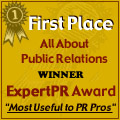|
by
Joan Stewart
The Publicity
Hound
 If
you're pitching stories about your company to the media, but photos are an
afterthought, you could be missing fabulous opportunities for publicity. If
you're pitching stories about your company to the media, but photos are an
afterthought, you could be missing fabulous opportunities for publicity.
Journalists say a good photo can move your article from the back of a
magazine to the front. Photos can be the deciding factor when you're
pitching a story idea. An editor who knows that you can provide photos, or
that their own photographer can take photos of something interesting,
might be encouraged to say "yes" to your story idea.
Here are 11 tips for using photos and graphics for public relations.
1. Make sure you have
good-quality, above-the-shoulders photos of all your experts who are
likely to be interviewed by the media.
2. Consider asking your photographer to shoot "environmental
portraits" of your experts. An architect, for example, might be
shown holding several rolled up architect's renderings under her arm. A
construction executive can be shown holding a hard hat or other tools of
his trade. Weekly newspapers that don't have big photo staffs would
probably welcome these photos.
3. Have interior and exterior shots of your company available for
the media. The interior shots can show people at work. Please, no cliche
"on the telephone" or "working at the computer"
shots.
4. Submit photos with news releases about routine announcements
such as new hires, promotions, retirements, awards, etc.
5. Pie charts, bar charts and other graphics can often help readers understand complicated issues such as budgets. Offer to supply
information to media outlets so they can create their own graphics to
accompany the article they're writing about.
6. If you're sponsoring an event that doesn't necessarily warrant
a story, call the photo desk at your local newspaper and let
photographers know what's happening.
7. If a photographer from a newspaper or magazine takes photos at
your company, never demand to see the negatives, or dictate what photo
they should use with the article, or ask for free copies of prints. The
negatives are the property of the media outlet, and the media maintain
full control over their use. If you want prints, expect to pay for them.
8. Make sure all photos are scanned at print-quality 300 dots per
inch and available for instant download at your website, preferably
under a button called "Media Room" that can be accessed from
the homepage.
9. Avoid using big clunky photos at your website because they
slow down the time it takes a page to load.
10. Never, ever ask a newspaper or magazine to take photos of a
check-passing, ground-breaking or ribbon-cutting ceremony. The media
hate these staged events. And don't wimp out by uploading these
cheesy-looking photos to your expensive website.
11. Offer an architect's rendering instead of a ground-breaking
shot. In place of a check-passing photo, take a photo that illustrates
what the money will be used for. Instead of a ribbon-cutting photo, how
about a photo of a business person with a customer on the first day of
business?
Are you starting to get the
picture? Photos and graphics can be a powerful publicity tool--but only if
you use them.
Joan
Stewart, aka The Publicity Hound, is author of the ebook
"How to Use Photos & Graphics in Your Publicity
Campaign."
She also publishes the free ezine "The Publicity Hound's Tips of the
Week." Subscribe at http://www.PublicityHound.com
More
Articles | Submit
Your Article | PR
Subjects
About
Public Relations Homepage
Contact Us
|



